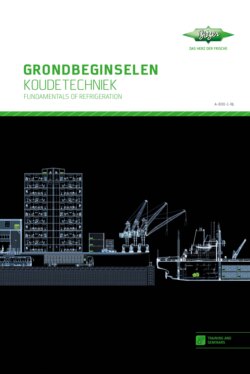Читать книгу GRONDBEGINSELEN KOUDETECHNIEK / In twee talen Nederlands/Engels - Volker Stamer - Страница 34
На сайте Литреса книга снята с продажи.
ОглавлениеEen COP van "3" betekent dat 1 kW aandrijfvermogen
van de compressor 3 kW koelvermogen aan de
verdamper oplevert.
Naast de eigenschappen van het koudemiddel, het
rendement van de componenten en de configuratie van
het systeem, hebben de bedrijfsdrukken (verdampings-
en condensatietemperatuur) een doorslaggevende
invloed op de COP.
Het rendement van een warmtepomp wordt bepaald
aan de hand van zijn prestatiecoëfficiënt εWP c.q. de
COP. Voor de prestatiecoëfficiënt van de warmtepomp
wordt de verhouding berekend tussen het condensor-
vermogen (thermisch vermogen) en het gebruikte
aandrijfvermogen van de compressor.
De COP met betrekking tot de capaciteit van de con-
densor (ook wel COPWP genoemd) is altijd "1" hoger
dan de COP van het koelvermogen (zie hierboven).
Daarom moet, om verwarring te voorkomen, altijd de
exacte referentie worden vermeld.
Een verwarmingscoëfficiënt "4" betekent dat 1 kW
aandrijfvermogen van de compressor 4 kW warmte-
capaciteit aan de condensor oplevert.
Opmerking:
Voor een hoge prestatiecoëfficiënt geldt: Een lage con-
densatietemperatuur (condensatiedruk) en een hoge ver-
dampingstemperatuur (verdampingsdruk). De prestatie-
coëfficiënt mag niet worden verward met het rendement.
De prestatiecoëfficiënten worden bepaald op een test-
bank onder standaard bedrijfsomstandigheden. Deze gel-
den dus alleen voor de gespecificeerde bedrijfscondities.
3.1.4
Seizoensgebonden EER (SEER), COP/EER
(SEPR), seizoensgebonden COP (SCOP)
Voor verschillende soorten installaties (bijv. airconditio-
ners, condensing-units, vloeistofkoelers) EU Ecodesign
Directive, seizoensgebonden EER- (SEER) of COP/
EER (SEPR)- waarden worden opgegeven en voor
warmtepompen seizoensgebonden COP-waarden
(SCOP). Het grote verschil tussen COP en EER: de
prestatiemeting en de opgave van de prestatiegegevens
zijn niet alleen gebaseerd op één enkele temperatuur
en vollast conditie, maar op vier verschillende referent-
iepunten en koellasten. Voor de koelapparatuur voor
comfort airconditioning liggen deze referentiepunten
(meetpunten) bij 20 °C, 25 °C, 30 °C en 35 °C buiten-
temperatuur, en voor condensatie-units en chillers voor
A cooling coefficient of performance ‘3’ means that
1 kW of compressor drive power delivers 3 kW of re-
frigerating capacity at the evaporator.
In addition to the refrigerant properties, the compo-
nent efficiencies and the system design, the operating
pressures (evaporation and condensing temperature)
have a decisive influence on the cooling coefficient of
performance.
The efficiency of a heat pump is evaluated using the
heat pump coefficient of performance εHP, COP. The
ratio of the condenser capacity (heating capacity) and
the compressor drive power is used for the calculation
of the heat pump coefficient of performance.
The COP relative to the condenser capacity (also
referred to as COPHP) is always greater by ‘1’ than the COP relative to the refrigerating capacity (see above). Therefore, to avoid confusion, the exact reference should always be given.
A heating capacity coefficient ‘4’ means that with
1 kW of compressor drive power, 4 kW of heating
capacity is provided to the condenser.
Note:
A high coefficient of performance means: condensing
temperature (condensing pressure) low, evaporation
temperature (evaporation pressure) high. The coefficient
of performance should not be confused with efficiency.
The coefficients of performance are determined on
a test bench under standard operating conditions.
Consequently, they only apply to the specified
operating conditions.
3.1.4
Seasonal EER (SEER), COP/EER (SEPR),
seasonal COP (SCOP)
Under the EU Ecodesign Directive, seasonal EER
(SEER) or COP/EER (SEPR) values must be declared
for various cooling products (e.g. air conditioners, con-
densing units, liquid chillers) as well as seasonal COP
(SCOP) values for heat pumps. The major difference
to COP and EER: the performance measurement and
declaration of performance data is based not only on
a single temperature and full-load conditions, but on
four different reference points and load conditions. For
cooling equipment in comfort air conditioning, these
reference points (measuring points) are 20°C, 25°C,
30°C and 35°C ambient temperature, and for con-
densing units and liquid chillers for process cooling
36
Koeltechnische specificaties // Refrigeration parameters
